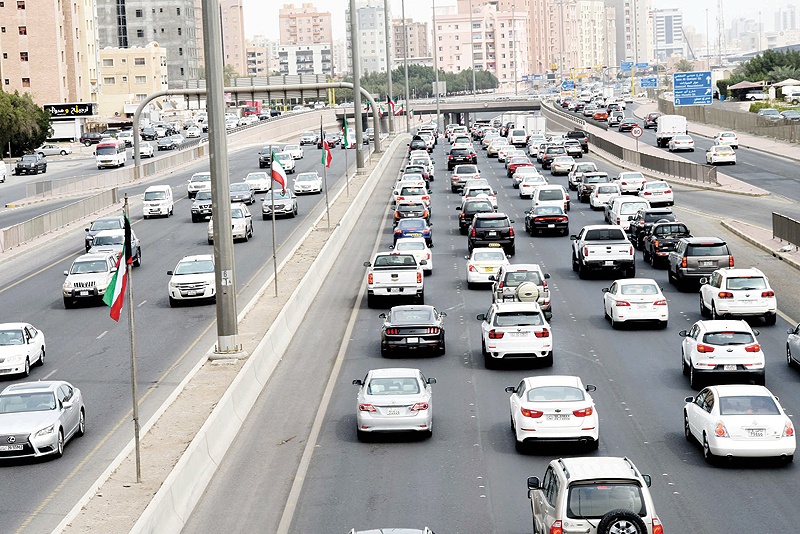Kuwait's streets are a hodgepodge of numbers, names and nicknames. Ask for directions and you might be told take the 30, get off at Fahaheel Expressway or turn onto Istiqlal Street. Part of the confusion stems from the many different communities in Kuwait. Similar to some areas, different communities use different names for streets. Westerners, for instance, tend to refer to the numbered highways as the 30, 40, 50 or 55 and so on. Locals and those who have grown up in Kuwait seldom use the numbers but instead refer to these highways and streets by their given names.
A special 'nomenclature committee' at the Kuwait Municipality was established solely for the purpose of naming Kuwait's streets. Kuwait Times interviewed Head of the Committee and the Assistant Director General for Projects Affairs Yousef Al-Munawer to learn more about how names of streets are chosen and what are the issues surrounding the process.
The nomenclature committee was formed by the Municipal Council and consists of members from the Municipality and other institutions including the Ministry of Information, Amiri Diwan, the Cabinet, Kuwait Writers Association, National Council for Culture, Arts and Letters and the Gulf Studies Institution. The committee is currently not empowered to set new criteria for naming.
Based on numbers but still named
All streets in Kuwait have been assigned numbers. "Addresses in Kuwait are based on numbers, and the names are just an addition. Each street has a number, so the official address includes this number and not the name. Even Arabian Gulf Road has a number - 25. When the name of any street is changed, the Municipality sends official letters to various institutions in charge about this change," Munawer told Kuwait Times.
Names, however, are also used and can come about in a variety of ways. Some streets were named by Amiri decree, such as naming the Sixth Ring Road after the late parliament speaker and prominent businessman Jassem Al-Khorafi, and the Fifth Ring Road after the late ruler of the United Arab Emirates Sheikh Zayed bin Sultan Al-Nahyan.
Both the naming committee and ordinary citizens can recommend names for streets. Quite often, name suggestions are made to honor a prominent member of the community or someone who has made great achievements in the country. "A family can suggest naming a street after one of its members who passed away. We then research and study [the suggested person's] achievements. Here, we also cooperate with the Researches and Studies Center, the Ministry of Awqaf and Islamic Affairs and other related institutions," Munawer said.
A street by any other name
Confusion arises though when streets are known by locals and residents by a variety of different names. The so-called Share'a Al Hubb (Love Street) is a well-known and popular street between Daiya and Dasma, but most foreigners will have no clue of its location unless you call it the Second Ring Road. The so-called Restaurants Street in Salmiya is another famous local destination and most folks know it based on that name, but in reality it's called Amr bin Al-Aas Street.
Streets may also seem to have different names because the names represent different segments of the road. "If a road is intersected by another road, traffic light or roundabout, for instance, then it may have a different name, such as the Maghreb Highway, Riyadh Expressway or Istiqlal Road," explained Munawer. A good example of this is Gulf Road, which becomes Balajat Street in Ras Salmiya, and after passing through Al-Bidaa Roundabout, becomes Al-Ta'awon Street.
Famous and local personalities
Sometimes the name of a road may be changed. "We have changed the name of many streets that were named after historical personalities after we found that their biographies were not honorable. For instance, Al-Azraq Road was recently the subject of much discussion on social media. We found that Al-Azraq was an infidel and against the Muslims during his time. So we suggested a change to the municipal council, which has to get approval from the Cabinet," he said.
Also, some street names have been modified and approved. "For instance, Al-Zahra Street was changed to include the full name of the person it's named after - Fatima Al-Zahra Street. A similar situation occurred with Sukaina Street, which was changed to Sukaina bint Al-Hussein Street. These were old street names and we recently revised the names on all the signs," said Munawer.
There have also been political problems with some street names. "For instance, Hassan Al-Banna Street is named after the founder of the Muslim Brotherhood. It has been proposed many times to change the name, but we couldn't as it was causing political problems. It's not easy to change the name of streets named after political personalities, though a few have been changed. So we have stopped approving names of contemporary religious personalities," concluded Munawer.
For those driving on Kuwait's streets, the naming system can seem as arbitrary. Directions and popular street addresses aren't always clear. The evolution of street names, however, can provide interesting clues to Kuwait's local history as well as important regional events.
- Shared from Kuwait Times archives
By Nawara Fattahova


